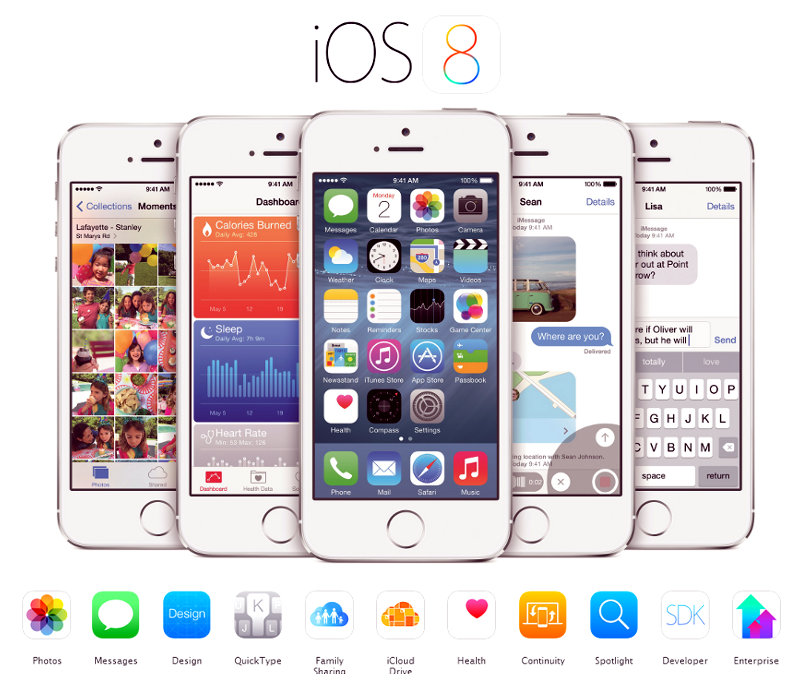To much applause, Apple’s CEO unveiled their latest mobile operating system, iOS 8, at the WWDC event in San Francisco yesterday. It’s easily one of the biggest iOS releases ever, but this time, rather than having a bucket load of new end user features, Apple has instead focused on tons of developer features. Most of these features are usually invisible to the end user, and make an impact only when widely utilized by developers. But there are some iOS 8 developer features that already show potential, in terms of prospective apps and functionality for the us, the end users. So we have picked out 5 completely new ones, which, we think, will matter to us, when iOS 8 lands on our iPhones.
Homekit –
Apple has been rumoured to enter the home automation space for quite a long time now, and with iOS 8, it is finally happening. We had already seen some crazy apps for controlling all the devices from a hotel room and even device-specific apps for smart LED lighting like Phillips Hue or Thermostats like Nest, but they all used their own technologies and platforms, making control of different items app-specific. Apple’s Homekit will provide a common network protocol for all the devices, so that the device manufacturers can take advantage, and build for a common platform. It will also support secure pairing, using which only designated iPhones or Apple devices can control them. This allows for interesting scenarios where “scenes” can be created depending on the mood. Also exciting is the addition of Siri voice command support for Homekit, using which you can dictate commands like “Open the pod garage doors” and it will actually open it for you, or like Craig Federighi said “I’m going to sleep” can make sure all the lights are switched off without you manually doing it in the app.
Impact – Apple’s clout will help gain support for many of these new smart home devices. Expect a bigger push, and hey, Siri integration is icing on the cake.
Metal –
Metal is Apple’s own take on providing game developers low level access to the underlying A7 chip. This has been possible in gaming consoles, and more recently, even in PC graphics chips, thanks to AMD Mantle and the upcoming Direct X 12, but in mobile, Apple says this results in a 10x performance increase. Folks from Unreal Engine showed off a demo app that pushed a lot of pixels at the event, and according to them, console quality graphics are now entirely possible on Apple devices. EA is already said to be working on Plants vs Zombies Warfare for the iOS platform, which will be a direct port of their console game. The Metal API is said to be a replacement for the OpenGL ES APIs that are currently used by game developers and game engine developers. The latter are supposed to reap the benefits of this advancement and then later pass on the benefits to developers using their engines.
Impact – Better looking games with more performance on iOS compared to other mobile platforms. Android has no low level APIs and Windows Phone will get them only with Direct X 12.
Custom actions –
Custom actions are a part of the set of extensibility features announced with iOS 8. Basically “custom actions” is like running a part of some app’s feature, without going to the app. Let us say you want to watermark a photo using an app. You might have already set the watermark on the app and may be you just want to apply it on one of your photos. So, all you do is click on the options button, which you usually do for sharing, and now the watermarking app can have an icon in the bottom row, which, on click, will run that watermarking action for you. Another great example that Apple gave, in their presentation is Bing Translate. Without going into the app, or even selecting text, the presenter was able to completely translate that page using a custom “bing translate” action. This translated the whole page to English by default, and worked without going into the app.
Impact – Apps can permeate and enhance the experience without a jarring difference in the UI. Extensibility is generally awesome.
App bundles –
Apple’s app store will now support “App bundles” which are basically just bundles of apps that developers can sell at a discounted price. This idea was initially pioneered for the Mac by third parties, but Apple has sought to implement this as a first party feature on iOS’ app store, because, lets face it, that’s the only way to do it. App bundles can and will drive more app adoption, which are great for developers, and the discounted prices are great for the users.
Trending search –
Apple will add a “trending” list to its search page on the app store. This might be familiar for Twitter users, but on the App store side, this has been implemented for the first time, and will really help users find out all the trending apps or games. For example, this could help surface the latest search terms that are popular at that point in time, so users don’t miss out on the trend. From a developer’s point of view, this only means more adoption of the popular app. Forget popular lists or Top apps lists, the trending search could change the way you find apps.

